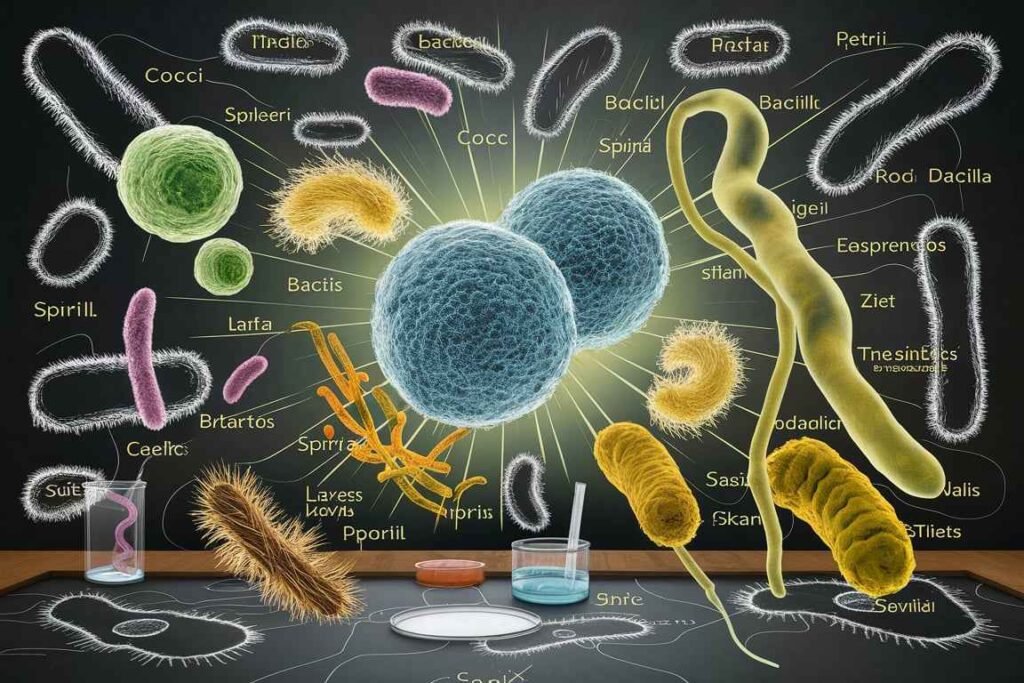Enumeration of bacteria refers to the process of counting the number of bacteria in a given sample. This process is essential in various fields, including microbiology, food safety, environmental science, and clinical diagnostics, as it helps determine the microbial load and assess the safety and quality of products and environments.
Table of Contents
Enumeration of Bacteria
To determine the quantity of viable bacteria in a sample, the plate count technique—also referred to as the viable count method or standard plate count (SPC)—is a basic microbiological technique. The idea behind this method is that, on a nutrient agar plate, every viable bacterial cell can proliferate and create a unique, visible colony. It is possible to calculate the amount of bacteria present in the original sample by counting these colonies.

Principle of Enumeration of Bacteria
Applying a diluted bacterial sample to a nutrient agar plate is the plate count technique. Each live bacteria develops into a discernible colony following the proper incubation period. Subsequently, the count of colonies is employed to approximate the quantity of live bacteria present in the initial specimen. Only live bacteria that are able to form colonies are counted using this method.
Materials and Equipment used in Enumeration of Bacteria
- Bacterial sample (water, food, clinical specimen, etc.)
- Nutrient broth or sterile saline for dilutions
- Pipette tips and sterile pipettes
- Nutrient agar in sterile petri dishes
- Glass rods or sterile spreaders (hockey sticks)
- Incubator temperature should be adjusted to suit the bacteria under study (usually 37°C).
- Marker for plate labeling
Procedure
Preparing the Sample:
To guarantee a countable number of colonies, prepare the bacterial sample by several dilutions.
For instance: To create a 10^-1 dilution, add 1 mL of the original sample to 9 mL of sterile diluent (such as nutritional broth or saline). Blend thoroughly. Next, to create a 10^-2 dilution, take 1 mL of this dilution and add it to 9 mL of diluent, and so on.
Vaccination
Transfer a measured volume (e.g., 0.1 mL or 1.0 mL) of the suitable dilutions onto the nutrient agar plate surface.
To guarantee that the bacteria are distributed equally, use a glass rod or sterile spreader to evenly distribute the inoculum over the agar’s surface.
Embryology
To avoid condensation on the agar surface, invert the plates and incubate them at a temperature suitable for the bacteria under investigation, usually 37°C.
Once colonies are visible and countable, incubate for a minimum of 24 to 48 hours, or longer if necessary.
Counting colonies:
Count the number of colonies on plates with 30 to 300 colonies after incubation. The range selected strikes a balance between statistical reliability and correctness.
Plates with more than 300 colonies may contain overlapping colonies, making accurate counting challenging, whereas plates with fewer than 30 colonies are statistically less reliable.
Calculation:
Use the following formula to determine the amount of live bacteria present in the original sample:

- CFU stands for colony-forming units.
Example Calculation
If you count 150 colonies on a plate inoculated with 0.1 mL of the 10^-4 dilution, the calculation would be:

Merits
- Quantitative Results: Indicates how many live bacteria are present in a sample.
- Simple and Economical: Needs standard materials and equipment for the lab.
- Versatile: Fits a variety of samples, such as those from the food, water, environment, and clinical domains.
- Differentiation: Enables bacterial colonies to be distinguished from one another by their shape.
Limitations
- Time-consuming: Takes at least 24 to 48 hours for colonies to form during the incubation phase.
- Only counts viable cells—that is, live bacteria with the ability to form colonies—avoids non-viable or damaged cells.
- Colony Clumping: Certain bacteria may group together, which could cause the true quantity to be underestimated.
- Manual counting is prone to interpretation errors and human error; automatic colony counters are helpful but not always accessible.
Applications
- Microbial load testing: Evaluating the microbiological quality of food, drink, and water to guarantee safety and adherence to regulations.
- Clinical diagnostics: Measuring the amount of bacteria in patient samples to help with diagnosis and therapy tracking.
- Monitoring the environment: Calculating the amount of bacteria present in environmental samples, such as water and soil.
- Research: Examining how bacteria proliferate, survive, and react to various environments and treatments.
Frequently Asked Question
What is Enumeration of Bacteria ?
Enumeration of bacteria refers to the process of counting the number of bacteria in a given sample. This process is essential in various fields, including microbiology, food safety, environmental science, and clinical diagnostics, as it helps determine the microbial load and assess the safety and quality of products and environments.
What are the 4 methods of enumeration?
The four methods of enumeration are:
1. Plate Count Method
2. Direct Microscopic Count
3. Turbidity Measurement
4. Most Probable Number (MPN)
What is enumeration of bacteria from soil?
Enumeration of bacteria from soil is the process of estimating the number of bacterial cells present in a soil sample. This typically involves diluting the soil, plating it on nutrient agar, and counting the resulting colonies to determine the bacterial population.
Related Article
MRS Broth test: Principle, Composition, Procedure, and Results interpretation




